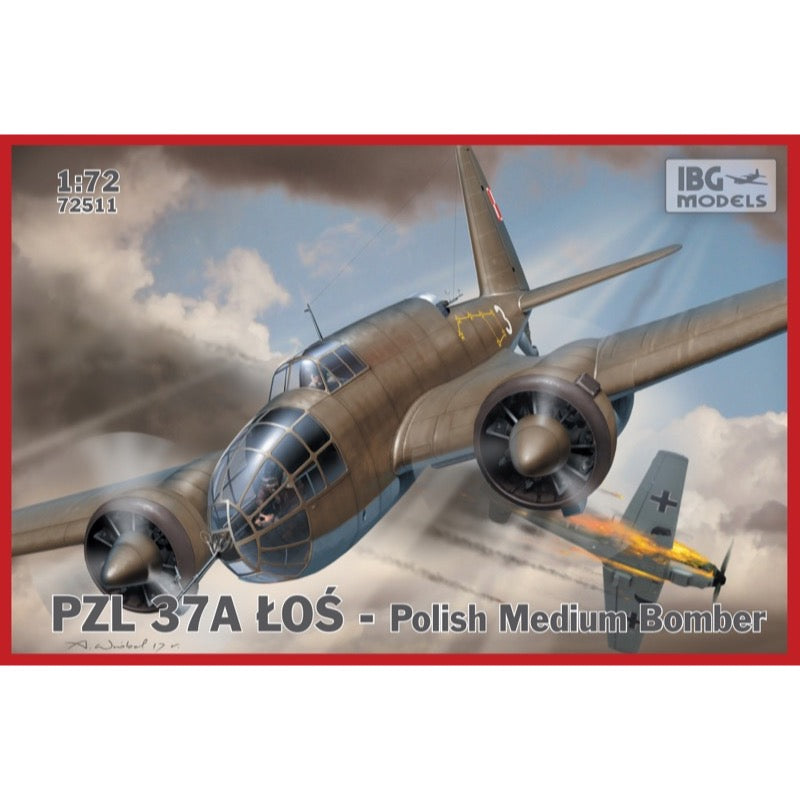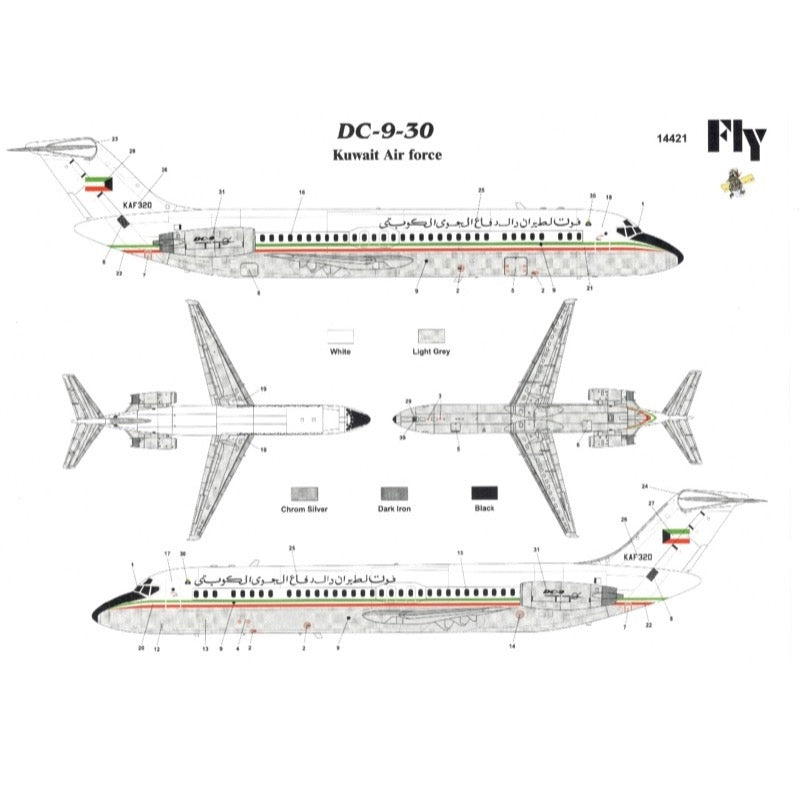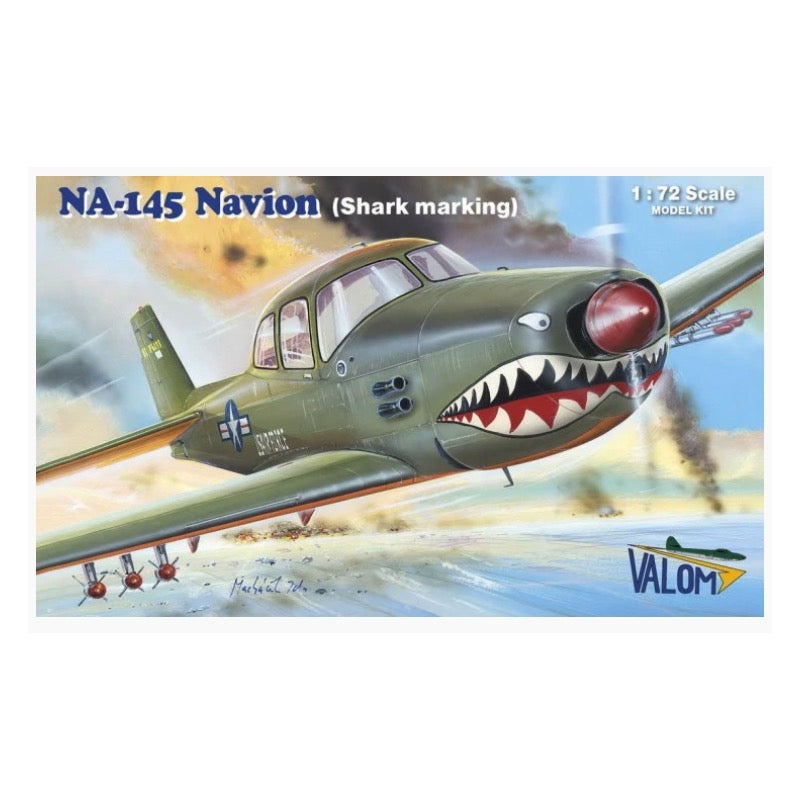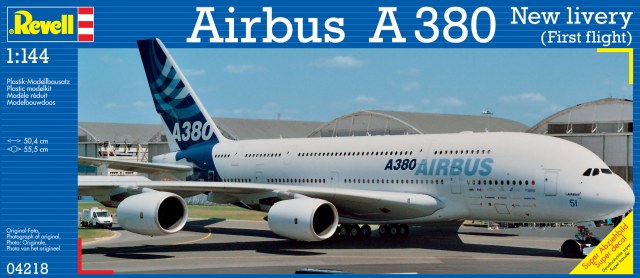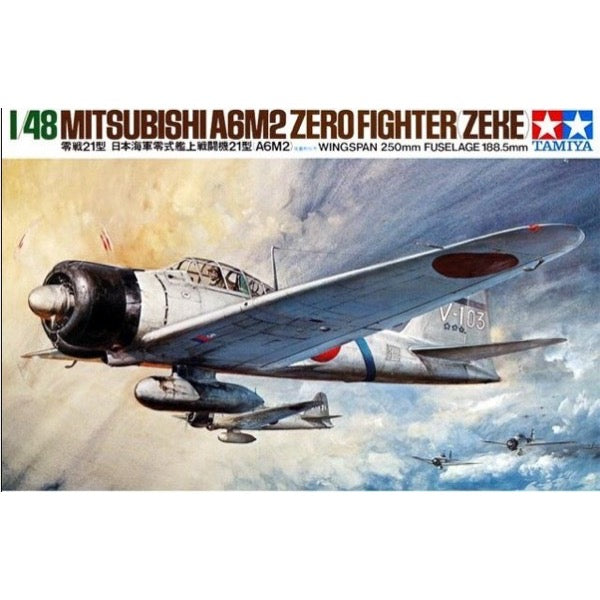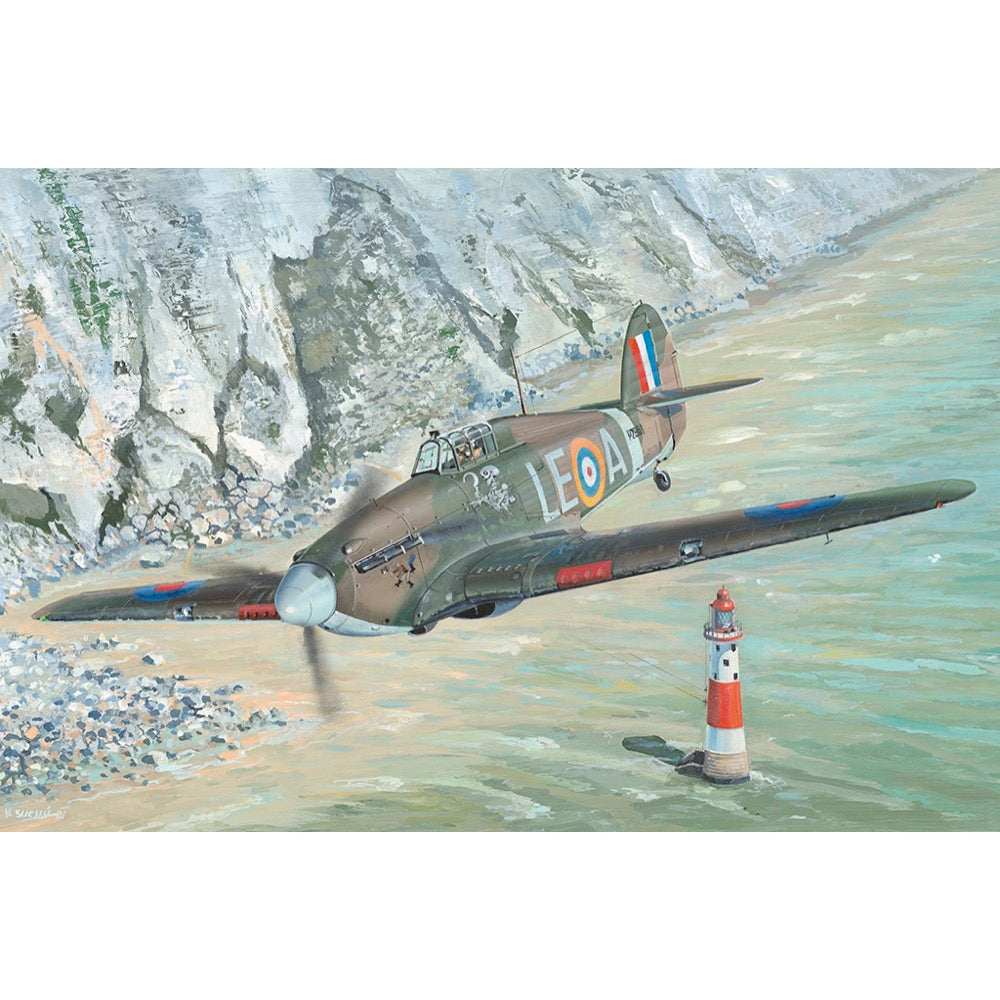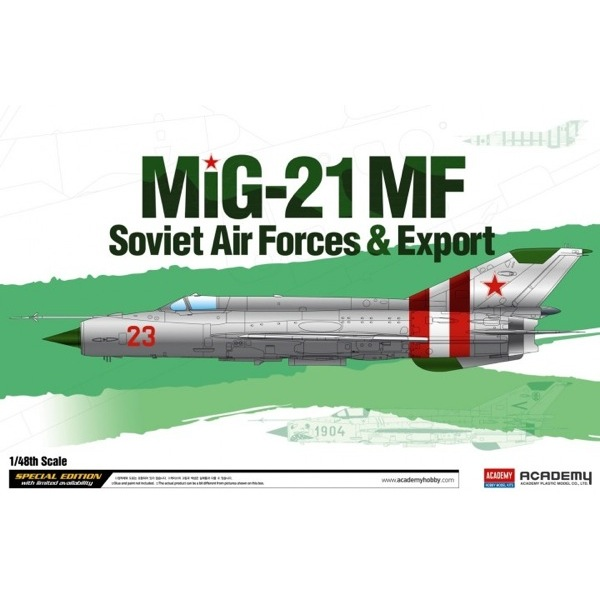
Academy 12311 1/48 MIG-21 MF "Soviet Air Force & Export" Le:
The Mikoyan-Guriewicz MIG-21 (NATO: Fishbed) is a Soviet light fighter with a semi-hull structure made of duralumin, with a mid-wing design, with a delta blade with a slope of 57 degrees. The prototype flight took place on June 16, 1956. The prototype of the MIG 21 is considered to be the E-5 prototype powered by the RD-11 engine. After its flight, several more prototypes were created, which, incidentally, were breaking various international airspeed records. The experience gained from them was used to improve the E-5, and finally, the aircraft was sent to mass production as the MIG-21F-13 in 1959. There are over a dozen basic versions in production, and together with various subversions, the number of MIG 21 types can be estimated at several dozen! The most notable of these is the first serially produced MIG-21F. It replaced the MIG-21PF version with the RP-21 radar and the R-11F2 engine. The next development version is the MiG-21R, which is a reconnaissance aircraft. Several training versions were also created, the first of which was the MiG-21U-400. The MIG-21 proved to be a very successful project, with great performance, easy to fly and cheap to produce. The quality of construction is evidenced by the fact that in the 90s there were development versions of this aircraft, which were more than 30 years old. The machine was exported to all countries of the former Warsaw Pact and to the whole multitude of Arab and African countries. The MIG-21 took part in most of the armed conflicts of the 1960-1980 period, including the Vietnam War, the Six-Day War (1967), the Iran-Iraq War (1980-1988). Technical data: length: 13.46 m, wingspan: 7.15 m, height: 4.1 m, maximum speed: 2130 km/h, rate of climb: 120 m/s, maximum range: 1100 km, maximum ceiling 19000 m, armament: fixed - single 23 mm GSz- 23 cannon (M version), suspended - up to 2000 kg load.
This is an injection-plastic aircraft model kit.
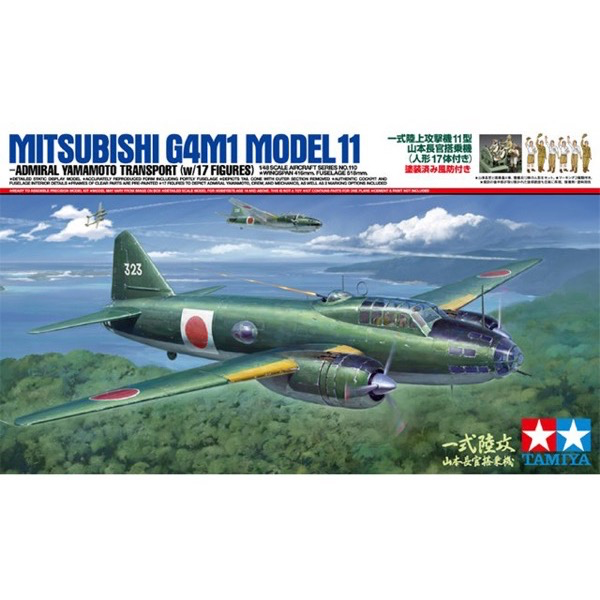
Tamiya 61110 1/48 Mitsubishi G4M1 Yamamoto with 17 Figures
Battle Above Bougainville Island, April 18th, 1943
On the morning of April 18th, two G4M1 transports departed from the Rabaul Airbase to visit frontline units at Balalae, Buin. The first aircraft, No.323, had eleven people on board, including Admiral Isoroku Yamamoto. The second aircraft, No.326, had twelve people on board, including Vice Admiral Matome Ugaki. However, American forces knew of this trip thanks to code deciphering and ambushed the Mitsubishi G4M1 transports with a force of P-38 Lightning fighters. The loss of such a revered commander was at the same time a massive blow to Japanese forces and a morale boost for the Allies.
About the Mitsubishi G4M1 Model 11
The Mitsubishi G4M1 Model 11 was officially adapted in 1941 as the successor to the Type 96 bomber. Featuring a long flight range which enabled it to attack enemy fleets from land bases, it went on to serve as the IJN's main land-based bomber in the Solomon Islands in 1942. Most of the G4M1s during the Solomon Island campaign had their outer tail cones removed to provide a better field of fire for the tail-mounted 20mm cannon.
Features
-
1/48 scale plastic assembly kit of the Mitsubishi G4M1 Model 11. Length: 416mm, Wingspan: 518mm.
-
The tubular form of the G4M1 has been accurately reproduced.
-
Realistically reproduced tail cone with outer section removed.
-
Cockpit details, including instrument panel, gun sight, floor panel, and bulkhead, feature realistic details.
-
Canopy above the left side pilot seat, dorsal turret, and the aircraft's flaps can be depicted in either up or down position.
-
In addition to clear canopy parts, pre-painted canopy parts are also conveniently included.
-
Kit contains a total of 17 figures: 1 depicting Admiral Yamamoto, 1 observer, 2 pilots, 1 gunner, and 12 mechanics.
-
2 kinds of decals included to depict Admiral Yamamoto's and Vice Admiral Ugaki's transports respectively.

Zoukei Mura SWS7214401 1/72 and 1/144 Horten Ho 229
SETTING A NEW STANDARD FOR 1/72 SCALE! SWS QUALITY IN A PALM-SIZED MODEL! SMALL YET REALISTIC!
Pushing the limits of 1/72 scale!
Recreate the "Mysterious Bird" Horten with dense mechanical detail exceeding expectations of small-scale models!
THE 4 MAIN POINTS OF 1/72&1/144 Ho 229
- This SWS kit builds two models in 1/72 and 1/144 scales based on the unfinished “Ho IX V3” prototype, recreating what a finished Ho 229 might have been like if used in actual combat. Don’t miss this brand-new type of SWS kit, bringing you the next level of entertainment from learning through building, the true goal of scale models.
- Utilizing our experience and knowledge from developing the 1/32 and 1/48 kits, we successfully created a 1/72 scale model comparable to the larger sizes. The genius Horten brothers’ design philosophy is replicated in a level of detail that defies all expectations of small-scale models. Go ahead and start with 1/72 scale to experience the fascination of SWS kits.
- The 1/144 scale model’s assembly was made to be simple and quick, so that anyone can enjoy building it and learning from the accurate form based on thorough investigation of the actual aircraft and deep archival research. From 1/32 scale to 1/144 scale, experience the joy of collecting “the Luftwaffe’s mysterious wing” as SWS kits.
- The Ho 229 was developed in the final stages of the war in hopes that it would be the key to revival from the brink of defeat. The abundance of prototypes is part of what makes the Ho 229 a fascinating subject. RLM76 Light Blue was chosen to color the 1/72 scale version as a night fighter. For the 1/144 version, the standard camouflage was chosen for a fighter-bomber. With this kit you can enjoy both at once.
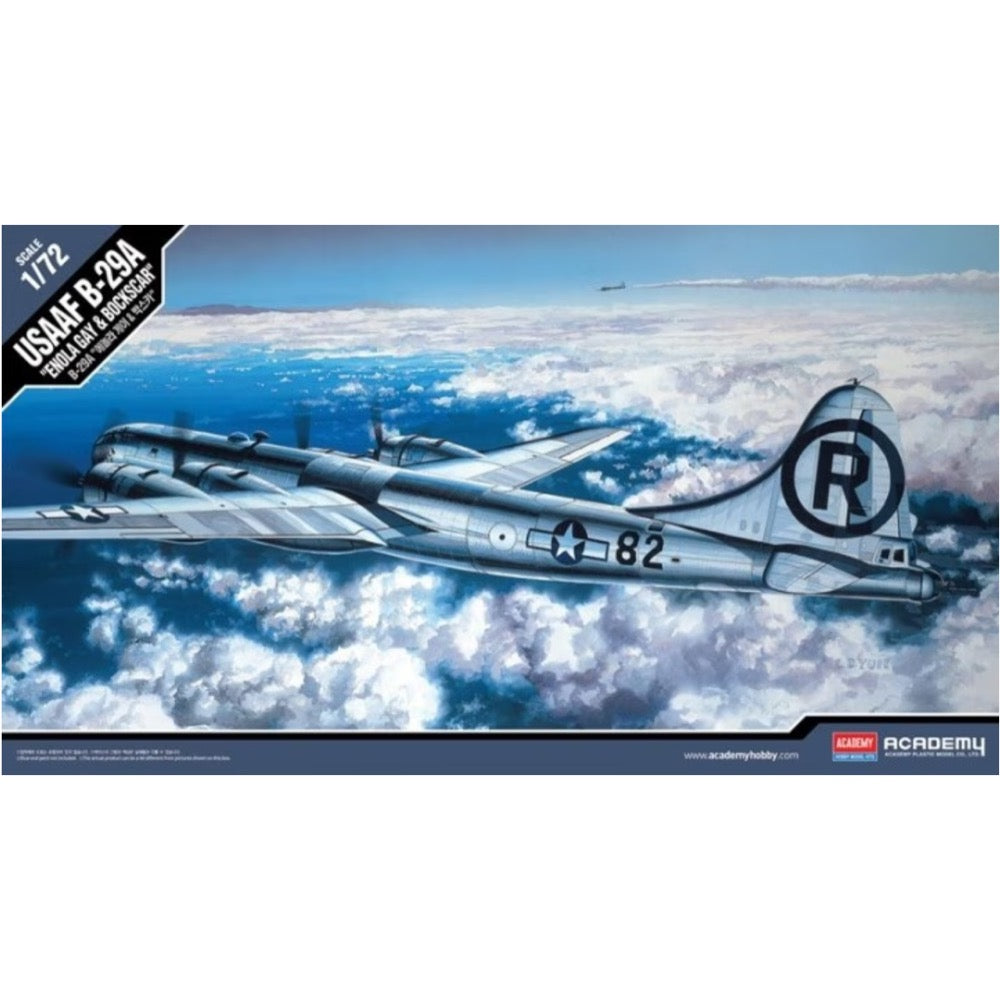
Academy 12528 1/72 B-29A "Enola Gay & Bockscar" Superfortress
The outbreak of World War II made USAAF strategists realize that they should focus on long-range bomber projects identified as VHB (Very Heavy Bomber). When it turned out that such an aircraft could also be used over the Pacific, the designation VLR (Very Long Range) seemed more appropriate. Such a project was launched in early 1940 by General Henry Arnold. Technical data: Maximum speed: 575 km/h, practical ceiling 9144 m, operational range: 5230 km, armament: fixed - most often 11 Browning machine guns caliber 12.7 mm. underslung - up to 9072 kg of bombs.
This is an injection-plastic jet aircraft model kit.
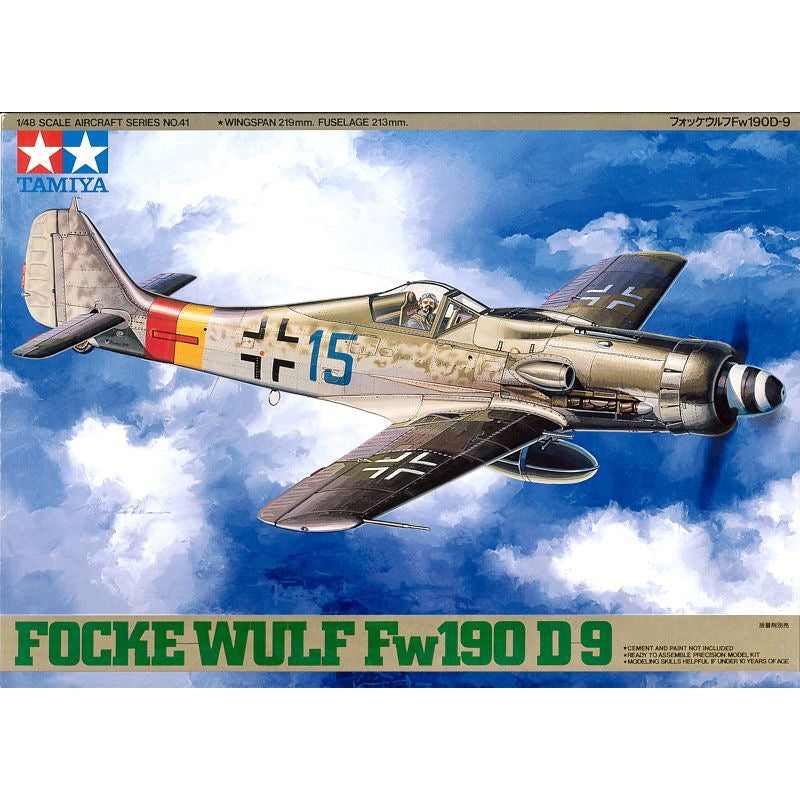
Tamiya 61041 1/48 Focke-Wulf FW190 D-9
Tamiya produces the most famous aircraft in the world taken from the most popular subjects in history, In the modelling world, 1/48 is one of the main scales for aircraft models, and this series includes numerous famous aircraft from around the world. Modelers can choose from WWII piston-engined fighters all the way to the latest jets.


